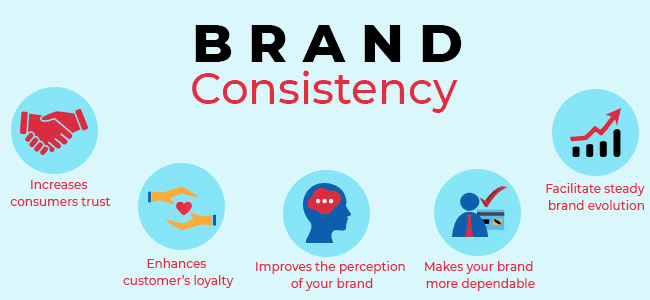Brand consistency refers to the uniformity and coherence in the way a brand presents itself across various touchpoints and communication channels. It involves maintaining a unified brand identity, messaging, and visual elements to create a cohesive and recognizable brand experience for consumers. Consistency is crucial for building trust, brand recognition, and positive associations.
Key aspects of brand consistency include:
-
Visual Identity:
- Consistent use of visual elements, including logos, color schemes, typography, and design elements, ensures a cohesive and instantly recognizable brand appearance.
-
Messaging:
- The language, tone, and style used in brand communication should remain consistent. This includes advertising copy, social media posts, website content, and any other written communication.
-
Brand Values and Personality:
- Consistency in conveying the brand's values and personality traits helps shape a coherent brand image. Whether the brand is perceived as friendly, professional, innovative, or trustworthy, this should remain consistent across all interactions.
-
Logo Usage:
- Ensure that the logo is used consistently in terms of size, placement, and color across different platforms and materials. A standardized logo contributes to brand recognition.
-
Color Palette:
- Consistent use of colors reinforces the brand's visual identity. A well-defined color palette contributes to brand recognition and helps create a cohesive brand presence.
-
Typography:
- Consistency in font choices and typography maintains a unified look and reinforces the brand's personality. Typography guidelines should be followed across various communication materials.
-
Imagery and Photography Style:
- The style of imagery and photography used in brand materials should align with the overall brand identity. Consistency in visual elements contributes to a cohesive and memorable brand image.
-
Product Packaging:
- If applicable, product packaging should align with the overall brand identity. Consistent packaging design reinforces the brand's presence on store shelves and contributes to a unified brand experience.
-
Advertising and Promotions:
- Whether online or offline, consistency in advertising and promotional materials helps create a unified brand message. This includes consistency in visual elements, taglines, and messaging.
-
Online Presence:
- Consistency across digital platforms, including websites, social media, and email marketing, is crucial. Maintain a consistent look, feel, and tone to create a seamless online brand experience.
-
Customer Service:
- Consistency in customer service interactions, from phone conversations to emails, contributes to a positive and reliable brand perception. Customer service representatives should align with the brand's values and messaging.
-
Brand Guidelines:
- Clearly documented brand guidelines provide a reference for maintaining consistency. Guidelines should cover all aspects of brand identity, including visual elements, messaging, and usage guidelines.
Benefits of Brand Consistency:
-
Brand Recognition:
- Consistency helps in creating a strong and easily recognizable brand, making it stand out in the minds of consumers.
-
Trust and Credibility:
- Consistent messaging and experiences build trust with consumers, reinforcing the brand's credibility.
-
Positive Brand Image:
- A unified and consistent brand image contributes to a positive overall perception among consumers.
-
Customer Loyalty:
- Consistent brand experiences foster customer loyalty, as customers know what to expect from the brand.
-
Effective Communication:
- Consistency simplifies communication, ensuring that brand messages are clear and easily understood by the target audience.
-
Competitive Advantage:
- A consistently presented brand can gain a competitive advantage by standing out in a crowded market.
-
Brand Equity Building:
- Over time, consistent brand experiences contribute to the development and strengthening of brand equity.
In summary, brand consistency is a fundamental aspect of effective brand management. It involves aligning all aspects of a brand's identity and communication to create a unified and coherent brand experience for consumers.
Thank you,

